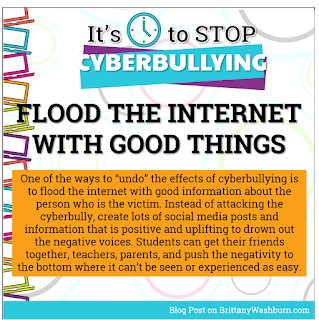It’s Time to STOP Cyberbullying
From kids to adults, cyberbullying is running rampant. As tech
teachers, there is a responsibility to teach students about being good (and
aware) digital citizens. If our students aren’t the perpetrators or the victims
– they’re the witnesses. In this post I’m going to cover what cyberbullying
looks like, what to do about it, and how to stop it.
teachers, there is a responsibility to teach students about being good (and
aware) digital citizens. If our students aren’t the perpetrators or the victims
– they’re the witnesses. In this post I’m going to cover what cyberbullying
looks like, what to do about it, and how to stop it.
What does cyberbullying look like?
Cyberbullying has impact all over the world, and it looks the same
in many places. When it comes to cyberbullying, it can look a lot like regular
bullying. Cyberbullying is attacking someone through the internet. It can
include insults, threats, gossip, rumors, and harassment. Cyberbullying could
include hacking someone’s account, or pretending to be someone else to
humiliate the victim. It could be in the form of words or video or pictures. It
could be on any social media platform, email, or text messaging. The bottom
line of cyberbullying is that a perpetrator is purposefully doing something
mean to someone else for the sole purpose of hurting or humiliating them. So,
it doesn’t really matter how it is done, the intent is always malicious.
in many places. When it comes to cyberbullying, it can look a lot like regular
bullying. Cyberbullying is attacking someone through the internet. It can
include insults, threats, gossip, rumors, and harassment. Cyberbullying could
include hacking someone’s account, or pretending to be someone else to
humiliate the victim. It could be in the form of words or video or pictures. It
could be on any social media platform, email, or text messaging. The bottom
line of cyberbullying is that a perpetrator is purposefully doing something
mean to someone else for the sole purpose of hurting or humiliating them. So,
it doesn’t really matter how it is done, the intent is always malicious.
For perpetrators of cyberbullying… Remember to emphasize that what
a person says on the internet is not private, and will be interpreted in the
worst possible light. Even if a student says, “It was just a joke,” it doesn’t
matter in a court of law. Whatever the words say, they will be interpreted
literally (especially in the case of threatening). Try to always be kind
everywhere, including the internet.
a person says on the internet is not private, and will be interpreted in the
worst possible light. Even if a student says, “It was just a joke,” it doesn’t
matter in a court of law. Whatever the words say, they will be interpreted
literally (especially in the case of threatening). Try to always be kind
everywhere, including the internet.
What to do about and how to stop cyberbullying?
It seems like every time I do a lesson on cyberbullying, within
the next week or two it comes up in class where someone did something that they
were just told not to do. Likewise, it’s important to note in the lesson that
there may be students in the room who are victims, perpetrators, or witnesses
of cyberbullying.
the next week or two it comes up in class where someone did something that they
were just told not to do. Likewise, it’s important to note in the lesson that
there may be students in the room who are victims, perpetrators, or witnesses
of cyberbullying.
For the victims… There is a good chance that if you’re on the
internet, expressing your opinion, someone else on the internet will insult or
heckle you (even if you don’t know who they are). So, one of the ways to stay
safe is to keep your social media, phone number, and email private. Do not
share this information with anyone who you don’t know.
internet, expressing your opinion, someone else on the internet will insult or
heckle you (even if you don’t know who they are). So, one of the ways to stay
safe is to keep your social media, phone number, and email private. Do not
share this information with anyone who you don’t know.
Block people. And if someone continues to change their information
to harass, then get help from an adult and report the person to the social
platform.
to harass, then get help from an adult and report the person to the social
platform.
For witnesses… Do something. Encourage the person who is being
picked on online. Say something nice. Don’t laugh. Don’t help the perpetrator.
Tell an adult about it. Report them to the social media platform. Don’t spread
the rumors and gossip. Be there for the person in need.
picked on online. Say something nice. Don’t laugh. Don’t help the perpetrator.
Tell an adult about it. Report them to the social media platform. Don’t spread
the rumors and gossip. Be there for the person in need.
Flood the internet with good things. One of the ways to “undo” the
effects of cyberbullying is to flood the internet with good information about
the person who is the victim. Instead of attacking the cyberbully, create lots
of social media posts and information that is positive and uplifting to drown
out the negative voices. Students can get their friends together, teachers,
parents, and push the negativity to the bottom where it can’t be seen or
experienced as easy.
effects of cyberbullying is to flood the internet with good information about
the person who is the victim. Instead of attacking the cyberbully, create lots
of social media posts and information that is positive and uplifting to drown
out the negative voices. Students can get their friends together, teachers,
parents, and push the negativity to the bottom where it can’t be seen or
experienced as easy.
More than anything, it is important for witnesses to help the
victims, and it is important for students to report and ask for help. The
internet is an amazing place, but try not to fight negativity with negativity.
Instead, drown out the negativity with positivity.
victims, and it is important for students to report and ask for help. The
internet is an amazing place, but try not to fight negativity with negativity.
Instead, drown out the negativity with positivity.
How do you address cyberbullying in the classroom? What is your
experience?
experience?
Here are some of the resources I use to teach Digital Citizenship (click on the pictures to learn more about each):









